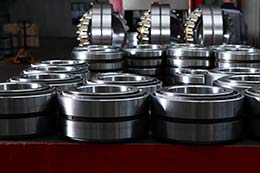 Master Bond high performance adhesives, sealants, and coating formulations are capable of being employed in the assembly of multiple types of mass finishing equipment for batch and continuous processing. End users can finish different sized/shaped parts/components made of ferrous/nonferrous metals, ceramics, plastics, glass, and rubber in bulk at one time. Surface finishing requirements are achieved by using equipment capable of deburring, burnishing, cleaning, polishing, descaling, de-flashing, surface hardening, rust removal, brightening, and grinding.
Master Bond high performance adhesives, sealants, and coating formulations are capable of being employed in the assembly of multiple types of mass finishing equipment for batch and continuous processing. End users can finish different sized/shaped parts/components made of ferrous/nonferrous metals, ceramics, plastics, glass, and rubber in bulk at one time. Surface finishing requirements are achieved by using equipment capable of deburring, burnishing, cleaning, polishing, descaling, de-flashing, surface hardening, rust removal, brightening, and grinding.
Some examples of mass finishing equipment are:
- Vibrator tumbler
- Barrel tumbler
- Centrifugal disc finishing machines
- Centrifugal barrel machines
- Shot blasting systems
- Drag finishing machines
- Polishing and buffing machines
- Honing machines
- Lapping machines
- Industrial part washers
- Industrial part dryers
Master Bond products offer manufacturers of mass finishing equipment design flexibility. Our compounds exhibit excellent bond strength between similar/dissimilar substrates with different coefficients of thermal expansion. They adhere well to complex shapes, distribute stress evenly, and are resistant to creep. Application specific grades are designed to protect against corrosion, chemical attack, wear, abrasion, extreme temperature and vibrational, rotational, as well as centrifugal forces. Many finishing equipment fabrications can utilize Master Bond products to improve efficiency, quality, and speed cycle times.
User friendly Master Bond compounds are able to contribute in the construction of both wet and dry mass finishing equipment. These versatile compositions are available in a variety of viscosities, cure speeds, and hardness. Most significantly they feature durability/toughness, superior wetting characteristics, can simultaneously bond and seal, fill voids and are long lasting in hostile conditions. They have been able to satisfy unique criteria for numerous situations while avoiding manual work. Mass finishing equipment enables parts to be more consistent, accurate, and uniform. This has led to a curtailment in rejects and a cutback in rework rates.
